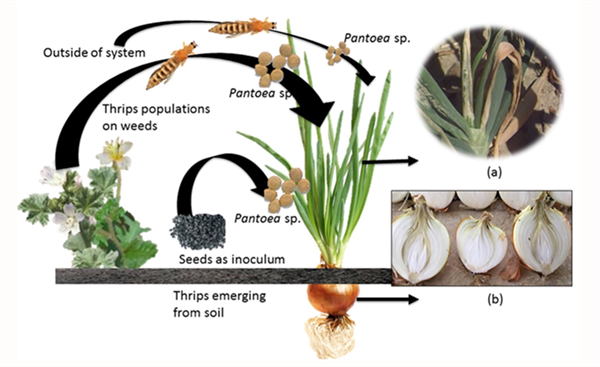Mar 22, 2023
Center Rot of Onion (2023)
DISEASE: Center Rot of Onion
PATHOGEN: Pantoea ananatis, Pantoea agglomerans, Pantoea alli and Pantoea stewartii subsp. indologenes
HOSTS: Onion (Allium cepa L.), garlic (Allium sativum L.), shallots (Allium cepa var. aggregatum L.), leeks (Allium ampeloprasum L.), chives (Allium schoenoprasum L.).
Symptoms and signs
Center rot of onion has not been a major problem in the desert southwest but when the environment is favorable, the disease can cause up to 90% loss. Foliar symptoms (symptoms on leaves) may start with water-soaked lesions spanning the length of the leaf blade, which gradually become blighted resulting in desiccation and collapse of the tissue. Experiments have shown that the bacteria can move from leaves to the bulbs, thus protecting foliage is important to manage the disease.
The bacteria can overseason to infect onions in a number of different ways. Like many bacterial pathogens, P. ananatis can be seed-borne with infested seed serving as a survival mechanism as well as a means of dissemination. It has been demonstrated that P. ananatis can be both naturally seed-borne and seed-transmitted in onion. The significance of the bacterium's ability to colonize seed is uncertain, as most onion seed production sites are located in arid climates but extremely important to understand to manage the disease.
Although P. ananatis can be seedborne, the proposed primary mode of transmission is by two insect vectors. Two species of thrips, tobacco thrips (Frankliniella fusca (Hinds)) and onion thrips (Thrips tabaci), have the ability to transiently acquire and transmit P. ananatis and P. agglomerans . The bacterium can persist in a non-circulative manner in the gut of thrips for 128 h, allowing the vector to infect plants over an extended period of time.
P. ananatis can survive epiphytically and endophytically on a wide range of hosts. These alternative hosts can serve as a source of inoculum in fields where susceptible crops are grown. In Georgia alone, 25 weed species, including carpetweed (Mollugo verticillata), common ragweed (Ambrosia artemisiifolia), crabgrass (Digitaria sanguinalis), common cocklebur (Xanthium pensylvanicum), curly dock (Rumex crispus), Florida pusley (Richardia scabra), sicklepod (Cassia obtusifolia), stinkweed (Thlaspi arvense), Texas panicum (Panicum texanum), vaseygrass (Paspalum urvillei), wild radish (Brassica spp.), yellow nutsedge (Cyperus esculentus) and other multiple crop plants were found to harbor P. ananatis populations asymptomatically.

Pic Credit: Colton Tew

Center rot-onion pathosystem: Multiple sources of inoculum (seed, weed and
thrips) contribute to center rot epidemic in field; A: foliar symptom resulting in
reduced yield (pre-harvest) and B: bulb rot in storage resulting in post-harvest
losses
Onion cultivars resistant to Pantoea sp. are not commercially available. Use of certified onion seeds is encouraged to avoid introduction of Pantoea sp. inoculum in the production field. Planting early maturing or mid-maturing onion varieties are often recommended for growers. Late maturing varieties provide a larger window for infection and a potential epidemic to occur, which are favored by thrips pressure, hot and humid conditions, and lack of effective bactericides. Overhead irrigation should be avoided as it promotes bacterial spread compared with sub-surface or drip-irrigation. Controlling thrips population can be an effective management strategy to reduce center rot incidence as these vectors play an important role in bacterial transmission.
Center rot management in onion fields relies heavily on copper applications mixed with an ethylenebisdithiocarbamate fungicide (EBDC), such as mancozeb, which growers may apply weekly as a protectant. In addition, researchers found P. ananatis strains to be copper-tolerant indicating overuse and potential risk of insensitivity to this chemistry. Repeated applications of copper sprays during susceptible growth stages can be effective only to a limited extent and does not offer a robust solution to the problem. Perhaps the inefficacy of these sprays could be due to thrips preference to colonize certain parts of the onion plant, e.g. the basal meristems (neck region).
The implementation of successful weed management strategies are important in reducing P. ananatis inoculum in the field. By reducing weeds, growers can potentially reduce initial inoculum.
https://www.apsnet.org/edcenter/disimpactmngmnt/topc/Pages/CenterRotOnion.aspx
LAST CALL FOR MELON POWDERY MILDEW TRIALS
If you are planning to include your treatments in the melon powdery mildew field efficacy trial, this is the last week to send the protocol. Contact Bindu Poudel-Ward (bpoudel@arizona.edu) for details and collaboration.
To contact Bindu Poudel go to:
bpoudel@email.arizona.edu
















